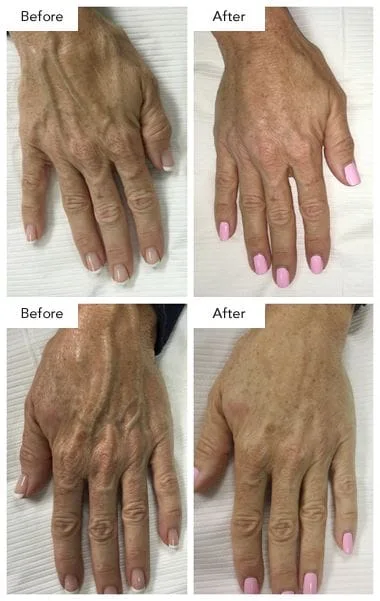

Your face changes as you age. Filling in wrinkles by adding volume can enhance your appearance. Even if you don’t have wrinkles, you may want to fill in some of those deep smile lines or use Radiesse treatment for scars. Radiesse can help you achieve this with a longer lasting result. This soft tissue filler is made of calcium hydroxylapatite, which is a normal constituent of bone. It has been used in Europe and the U.S. for tissue augmentation for many years, for treating deep expression lines, scars, and for lip enlargement. Radiesse has been effectively used to fill smile lines going from the nose to the corners of the mouth, marionette lines (the ones that hang down from the corners of the mouth) and to plump up lips. In addition, it is useful to add volume to the chin or cheeks and in correcting acne and other scars. The benefit of Radiesse is that it lasts 12 to eighteen months.
What Is Calcium Hydroxlyapatite? What are its advantages?
The injectable implant Radiesse is made up of calcium hydroxylapatite suspended in a carboxymethylcellulose gel. Calcium hydroxylapatite is a normal constituent of bone. The fact that Radiesse lasts up to two years, and not forever, is an advantage. As we get older, our skin thins. In fact, everything recedes as we age – out hairline, our gums, and yes, even our skin thins. If something permanent were injected into a skin crease (such as Silicone or Artefill), it may look good for 5-10 years. But when our skin eventually thins, and the injectable material does not diminish in size, it could appear as a lump in contrast to the surrounding skin. Since our skin thins as we age, permanent injectables can form lumps over time. Radiesse will last longer than hyaluronic acids such as Juvederm and Restylane. But Radiesse will not last forever, and therefore will not develop into bumps after initially looking good.
Safety
The calcium hydroxlyapatite in Radiesse is biosynthetically produced. No animals or animal products are used in their manufacture. Thus, there is no risk of transmitting any diseases, or causing allergic reactions in patients who are sensitive to common foods, such as beef, chickens and eggs. This also means that no skin testing is needed. And since the body has its own system for absorbing calcium hydroxlyapatite (it breaks it down into Calcium and Phosphorus, both normal products of the human body), it disappears over time without a trace.
Do I need to do a skin test?
No skin testing is required. Calcium hydroxylapatite is a normal constituent of bone, and does not cause chronic inflammation. The gel carrier does not require allergy testing either. No antibody reactions have been reported. Because of this, no testing is required prior to treatment.
Is it safe? What are the side effects?
Radiesse is safe. In fact, it is FDA-approved for injection into the vocal cords of patients with vocal-cord paralysis. Radiesse has been studied in many different surgical applications in the past, and no antibody reactions have been reported. It does not form chronic inflammation, and does not migrate. Side effects are very rare. Some patients report pain lasting up to 3 minutes during the injections, bruising, skin redness for a few days, or palpable firmness at the injection sites. All these side effects disappear over time. Lastly, since Radiesse is made from the same material that bone is, it will be visible upon x-ray.
Can a person suffering from an autoimmune disease be treated with Radiesse?
Clinical experience of treating patients with autoimmune disease is very limited, but there is no indication of an increased risk.
How It Works
The cellulose gel is absorbed by the body in six to eight weeks. The initial injection causes an inflammatory reaction, and the gel breaks down. As it is absorbed, it reacts with the surrounding tissue, which results in new collagen formation. Collagen replaces the gel, and is added to the calcium hydroxylapatite, which was also contained in the gel, making the skin plumper and fuller. So as the gel breaks apart, collagen replaces it, and this is why the material usually cannot be felt after six to eight weeks. Depending on the results desired, an initial treatment is usually maintained with regular follow-up treatments. How long the product stays in the skin is very individual. Many factors affect how long the product lasts, such as age, skin type, lifestyle and muscle activity. Follow-up treatments normally require a smaller amount of the product. Most patients choose to have a follow-up treatment one to two years after the initial treatment.
Effectiveness
The calcium hydroxylapatite used in these products is a normal constituent of bone, and lasts for years. This makes it possible for Radiesse to hold its shape and fullness, over a longer period of time. In a recent study, 91% of patients reported a good to excellent satisfaction rating, with 7% reporting a fair satisfaction, and 2% reporting a poor satisfaction.
How Is It Done and Does It Hurt?
The procedure takes about 30 minutes to perform, and is done in the office. After the application of a topical anesthetic cream, Radiesse is injected using a small thin needle. Substantial correction will be noted immediately as the Radiesse is injected. The permanent effects (up to 1-2 yeats) occur over the next few months. Touch up treatments may be required at times. There is no need for over-correction. Since these products are not of animal or human origin, a skin test is not needed. This means that the treatment can be done immediately.
What will I look like after the treatment?
Immediately after the treatment, you can expect slight redness, tenderness and/or bruising in the treated area. This is a normal result of the injection. The inconvenience is temporary and generally disappears in a day or two. Some patients experience swelling for about a week.
Do I need to avoid anything after a treatment?
- Avoid touching or excessive movement of the treated area for the next few days.
- Until the initial swelling and redness have resolved, do not expose the treated area to intense heat (e.g. steam rooms, jacuzzis, or sunbathing) or extreme cold.
- If you have previously suffered from facial cold sores, there is a risk that the needle punctures could contribute to another eruption of cold sores.
- If you are using aspirin or any similar medication, be aware that these may increase the bruising and bleeding at the injection site.




